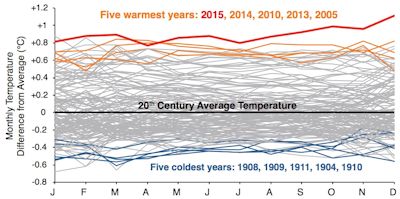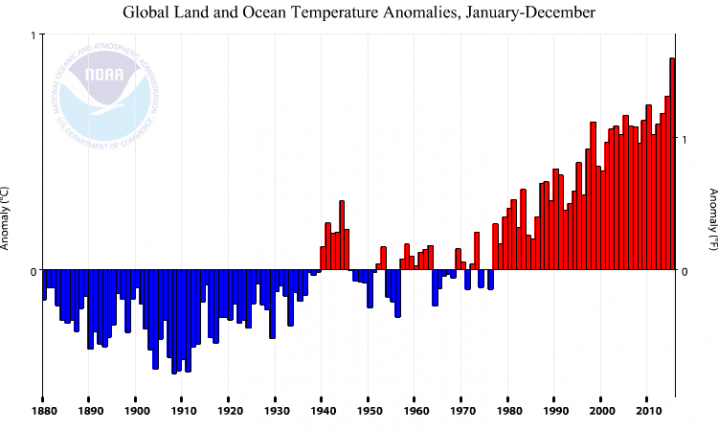Editor’s note: To stimulate discussion and debate, Coastal Review Online welcomes differing viewpoints on topical coastal issues. See our guidelines for submitting guest columns. The opinions expressed here are not those of Coastal Review Online or the N.C. Coastal Federation.
The inexorable rise in global temperatures, combined with a strong El Niño, puts 2015 in the record books while burying a key, but bogus, argument used by those who deny that our climate is changing.
Supporter Spotlight
Last year is officially the hottest year in recorded history, according to independent analyses released last week by NASA and NOAA scientists. If this sounds like something you’ve heard before: It is. This time last year, those same agencies announced that 2014 had been the hottest year in recorded history. But 2014 squeaked by the previous record set in 2010 by less than five-hundredths of a degree. 2015 blew the doors off that record by 0.16°C. That may not seem like much, but it’s the largest margin by which a previous annual temperature record was broken

Globally, all but two months, January and April, were the warmest in recorded history, as the above chart shows. And this warmth wasn’t limited to some random, remote area in the middle of the ocean or Siberia. In the United States, every single state east of the Mississippi River just had its warmest December on record.
RIP “Hiatus”
Temperatures last year are the latest nails in the coffin for an unfortunately popular misconception about climate change. Called the “hiatus” or “pause,” this oft-cited talking point says that global temperatures peaked in 1998 and have not risen since.
Temperatures last year were, in fact, unusually warm in 1998, thanks in part to a strong El Niño that year. During El Niños, warmer-than-usual ocean water covers the equatorial Pacific Ocean, typically resulting in warmer-than-average global temperatures. 2015 saw the start of the strongest El Niño since 1998, and so we would expect warm temperatures in 2015, all else being equal. But, as the plot in the accompanying chart shows, all else is not equal. El Niños have been getting warmer over the past 30 years, with the 2015 El Niño just the latest, and warmest, example.

The “hiatus” is based on comparing the strong 1998 El Niño to following years, which were at best weak El Niño. 2015 was a strong El Niño year, as well, making a comparison to 1998 more reasonable. Still, any comparison of a single year to another year is not only pretty silly, it is scientifically and statistically wrong. Earth’s climate is a complicated beast, and many different factors—a lot of which are still poorly understood—cause year-to-year swings in global temperature. If we look at the records over longer time periods, though, the trend becomes obvious: Global temperatures are increasing. This would be true regardless of whether 2015 was the warmest year on record or not.
Supporter Spotlight
2015 Context
What does a 0.9°C warmer world actually mean? To get context, we can step back to the last time when scientists know global temperatures were quite different from today: The peak of the last ice age, around 20,000 years ago. Even though thermometers were only invented 300 years ago, scientists can infer temperatures at the last ice age by measuring biological and geochemical artifacts that are related to temperature, such as tree rings, coral growth and ice cores. A recent compilation of hundreds of these measurements by the Intergovernmental Panel on Climate Change suggest the ice age world was, on average, 4.4 ± 1.3°C colder than the 20th century.

In other words, the temperature difference from average last year (+0.9°C) was up to 30% as large as the temperature difference at the peak of the last ice age, when ice sheets up to a mile thick covered North America down to New York, global sea level was about 450 feet lower—equivalent to the height of Great Pyramid of Giza—and wooly mammoths roamed across the high latitudes.
This isn’t an entirely fair comparison; there were undoubtedly warm and cold years during the last ice age. But the bigger point is this: Earth’s history is marked by massive physical and biological changes associated with relatively small changes in global temperature. A year that was 0.9°C warmer than average, on top of now 39 straight warmer than average years, is a change that simply cannot be ignored. Fortunately, the recent climate agreement in Paris is a key first step to potentially limit the consequences of climate change in the future, when the record warmth of 2015 will be easily forgotten under the weight of increasingly extreme years.







